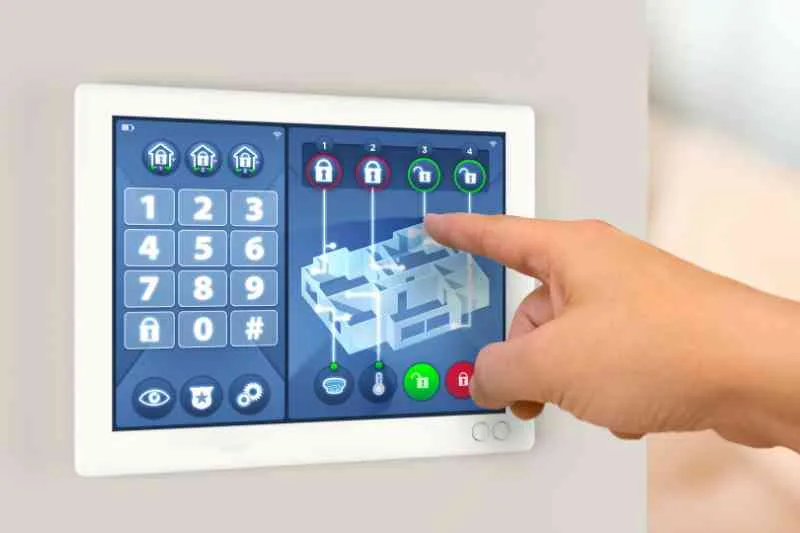Key takeaways
- Building automation systems integrate multiple systems into a single platform, while traditional controls operate independently.
- BAS improves energy efficiency by adjusting HVAC and lighting in real time based on occupancy and conditions.
- Traditional controls are simpler and lower cost upfront, but may lead to higher operational expenses over time.
- BAS provides predictive maintenance and centralized monitoring, reducing downtime and maintenance costs.
- Occupant comfort and satisfaction are higher with BAS due to dynamic adjustments for temperature, lighting, and workspace settings.
- BAS platforms are scalable and future-ready, allowing integration with new technologies without major infrastructure changes.

In modern commercial buildings, how systems are managed can significantly affect efficiency, occupant comfort, and operating costs. Building owners and facility managers often face the choice between implementing a building automation system (BAS) or sticking with traditional building controls. While both approaches serve the same fundamental purpose, they differ in terms of technology, integration, and operational impact.
This comparison is critical for anyone planning a new construction project or considering upgrades to an existing building. By understanding the distinctions, decision-makers can evaluate which approach aligns with their budget, goals, and long-term strategy. This post will explore the core features of BAS and traditional controls, highlight the differences in efficiency, monitoring, and ROI, and examine real-world scenarios where each approach makes sense.
Navigate this post:
- What is a building automation system (BAS)?
- What are traditional building controls?
- 7 Differences of building automation systems vs. traditional building controls
- Building automation systems vs. traditional building controls
- Use cases of building control systems
- ButterflyMX: State-of-the-art building automation and access control
- Building automation system vs. traditional building controls FAQs
What is a building automation system (BAS)?
A building automation system is a centralized network that controls a building’s mechanical, electrical, and security systems. Unlike traditional controls, which operate independently, a BAS brings multiple systems together on a single platform, enabling coordinated, intelligent management.
Key components of a BAS:
- Sensors detect environmental conditions such as temperature, occupancy, humidity, and light levels. Information from these sensors drives automated adjustments to building systems, helping maintain efficiency and occupant comfort.
- Controllers and field devices receive data from sensors and determine the appropriate response. Field devices then carry out commands, such as opening a valve or adjusting a damper, to maintain optimal building conditions.
- Actuators and outputs are the physical devices that implement changes in the building environment. They perform tasks such as turning lights on or off or modulating thermostat equipment in accordance with controller instructions.
- Communication protocols, such as BACnet or Modbus, allow devices from different manufacturers to communicate reliably. These protocols ensure that all components of the system can work together seamlessly.
- The user interface, or supervisory layer, allows building managers to interact with the system via dashboards. These interfaces provide real-time monitoring, analytics, and control over all integrated systems, making it easier to manage the building efficiently.
What are traditional building controls?
Traditional building controls are standalone or minimally automated systems. Each system, such as lighting, security, access control, or thermostats, typically operates independently and relies on manual switches, timers, or preset schedules.
For example, lighting might turn on and off according to a fixed schedule rather than actual occupancy, thermostats may require manual adjustments to regulate temperature, and security systems often have separate controls and monitoring with little coordination between them. Access points may require physical keys or codes, and alerts or notifications are limited.
While these systems can handle basic operational needs, they lack the integration and centralized intelligence of modern building automation systems. Monitoring is limited, adjustments must be made manually, and inefficiencies can add up over time, particularly in larger buildings with multiple systems.
7 Differences of building automation systems vs. traditional building controls
Understanding the differences between building automation systems and traditional controls can help building owners make informed decisions about system upgrades or new installations.
Here are seven differences between BAS and traditional controls:
- Efficiency and energy use
- Operational and maintenance costs
- Monitoring and feedback
- ROI and financial implications
- Occupant comfort and productivity
- Safety, security, and compliance
- Technology and future-proofing
1. Efficiency and energy use
Building automation systems dynamically optimize energy consumption. Sensors detect occupancy, daylight, and temperature changes, allowing the system to adjust lighting and HVAC in real time. This control reduces energy waste, minimizes unnecessary operation, and can lead to significant cost savings.
Traditional systems operate on fixed schedules or manual inputs. Lights and HVAC equipment may run in unoccupied spaces, resulting in higher energy consumption. While they are simpler to manage, traditional controls are less efficient in adapting to actual building conditions.
2. Operational and maintenance costs
Building automation systems provide predictive maintenance by continuously monitoring system performance. Faults can be detected early, reducing the likelihood of costly breakdowns and emergency repairs. Analytics tools also allow facility managers to prioritize maintenance based on system performance rather than fixed schedules.
Traditional systems rely on reactive maintenance. Without centralized monitoring, issues may go unnoticed until they become serious problems, resulting in increased downtime and repair costs.
3. Monitoring and feedback
With a building automation system, managers have access to real-time monitoring and centralized dashboards. This allows instant visibility into energy usage, system status, and occupancy patterns. Historical data and analytics can also be used for trend analysis and operational improvements.
Traditional controls provide limited monitoring. Facility teams often need to manually check multiple systems, and data collection is fragmented. Without centralized insights, identifying inefficiencies and planning upgrades is more difficult.
4. ROI and financial implications
Building automation systems require a higher upfront investment, but their long-term return on investment is usually higher than that of traditional controls. Energy savings, reduced maintenance costs, and improved operational efficiency often result in payback periods of two to five years, depending on building size and usage.
Traditional controls may have lower initial costs but higher operational expenses over time. Inefficiencies of standalone systems, combined with reactive maintenance and limited data, can outweigh the initial savings.
5. Occupant comfort and productivity
Building automation systems dynamically adjust conditions in response to occupancy patterns, weather changes, and individual preferences. This creates a more comfortable environment for occupants, which can positively affect productivity and satisfaction.
Traditional controls maintain static setpoints, which may not reflect actual building conditions. Occupants may experience discomfort due to overheating, insufficient lighting, or poor air quality, especially during unexpected changes in occupancy.
6. Safety, security, and compliance
Modern building automation systems integrate safety and security systems, including fire alarms, surveillance cameras, and access control, providing a centralized platform for monitoring and incident response. Compliance with building codes and regulatory requirements is also easier with detailed logs and reports.
Traditional systems are typically siloed with limited integration. This makes coordinated responses to emergencies more difficult and can complicate compliance reporting.
7. Technology and future-proofing
Building automation systems use IoT devices, wireless sensors, and analytics to remain adaptable to changing building needs. System upgrades, new features, and integrations can often be implemented without major disruptions.
Traditional controls rely on legacy equipment and protocols, making upgrades more challenging and expensive. Expanding functionality or integrating new systems often requires replacing significant parts of the existing infrastructure.
Building automation systems vs. traditional building controls
Use cases of building control systems
Building control systems help manage a building’s HVAC, lighting, security, and other operational functions. They can range from traditional standalone controls to fully integrated building automation systems, and they play a key role in improving efficiency, comfort, and safety for occupants.
Here are some buildings that can benefit from building automation:
- Commercial offices. A building automation system can optimize HVAC and lighting across multiple floors, adjusting conditions based on occupancy patterns and time of day. This not only reduces energy costs but also enhances employee comfort by maintaining consistent temperatures and lighting levels.
- Hotels. Automation improves guest experiences by dynamically adjusting temperature, lighting, and other in-room systems based on guest preferences and occupancy levels. Unoccupied rooms can automatically reduce energy usage, while occupied rooms provide optimal comfort.
- Healthcare facilities. Building automation systems in healthcare settings ensures precise control over air quality, temperature, and lighting, which are critical for patient health and staff productivity. Automated systems can maintain strict environmental standards in operating rooms, patient wards, and laboratories.
- Educational campuses. On large campuses, building automation systems manage HVAC, lighting, and security across multiple buildings. Classrooms, lecture halls, and administrative offices can be scheduled to adjust systems based on occupancy or class schedules. This reduces energy waste while maintaining comfortable conditions for students and staff.
- Multifamily buildings. Automation helps manage access control and common areas across apartment complexes. Systems can adjust based on resident occupancy, reduce energy use in unoccupied units, and improve comfort in shared spaces such as lobbies, gyms, and laundry rooms. Centralized monitoring also simplifies maintenance and enhances residents’ safety.
ButterflyMX: State-of-the-art building automation and access control
ButterflyMX supports building automation through a unified access control platform that connects with other building systems. It simplifies entry management while enabling integration with Access Control and security systems. Property teams can control doors, gates, elevators, and garage entries from the cloud without relying on on-site servers.
Benefits of using ButterflyMX include:
- Improved operational efficiency. ButterflyMX centralizes all access points, entry logs, and user permissions in one platform. This reduces the need for staff to manage multiple systems or manually track activity across different doors and gates. Streamlined workflows save time, reduce errors, and allow property teams to focus on higher-value tasks.
- Remote management. ButterflyMX enables teams to manage building access from anywhere. Managers can grant or revoke permissions, review entry activity, and coordinate with automation systems without being on-site. This flexibility improves response times for visitor access, maintenance coordination, and emergencies.
- Enhanced tenant experience. Residents and employees can use mobile-based access to unlock doors, gates, or elevators with their smartphones. When connected to building automation, this access can trigger personalized settings such as preferred lighting, temperature, or workspace configurations. This creates a smooth and convenient experience that increases satisfaction and engagement.
- Scalability. As a property expands or adds more automation technologies, ButterflyMX supports growth without major infrastructure upgrades. Its platform can integrate new access points, security devices, and automation tools, making it easier for property teams to scale operations and adapt to changing tenant and building needs.
- Better visibility. Property managers gain a complete view of building activity by monitoring access events alongside automation data. This visibility helps identify trends, detect anomalies, and plan proactive maintenance. Integrating access logs with automation tools allows managers to optimize energy use, schedule cleaning, and maintain equipment before issues occur.
Discover how ButterflyMX works:
Building automation system vs. traditional building controls FAQs
- What are the cost differences between the two systems?
- Can a traditional building control system be upgraded to a building automation system?
What are the cost differences between the two systems?
Traditional controls typically have lower upfront costs but can result in higher operational expenses over time. Building automation systems require a higher initial investment but often deliver long-term savings through reduced energy use, predictive maintenance, and improved operational efficiency.
Can a traditional building control system be upgraded to a building automation system?
Yes, many traditional systems can be retrofitted or integrated with building automation platforms, though the complexity and cost of upgrades depend on the existing infrastructure and system compatibility.

Get your free quote!
Fill in the form below, and we'll email you right back.
Want a free quote?
Fill in the form below, and we'll email you right back.
You’ll be redirected shortly...






